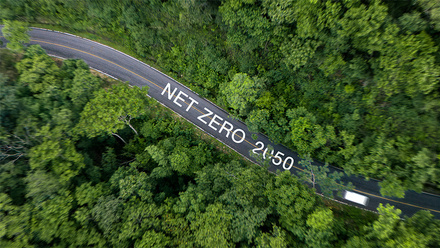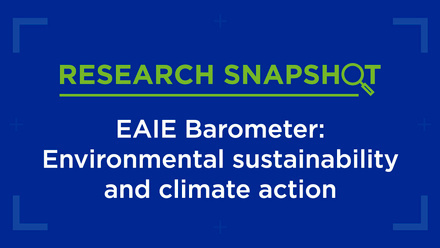How student learning can drive sustainable study abroad

Those of us that work in international higher education, particularly in student mobility, are driven to provide high-impact experiences across borders and across cultures for the primary purpose of cultivating global citizens. Global citizenship is still an evolving concept, but generally entails the elevation of difference – a consciousness about it, how to value it, how to leverage it, how to relate to it and how to communicate within it. These skills are applicable to any situation, and the climate crisis is no different.
The greatest potential for change does not actually lie within effective programme administration – it lies in effective student learning
In fact, given that the crisis is one originating in human activity and is a multi-lateral effort, it necessitates a human-centred, multi-lateral response to counter recent trends. The response must draw upon the values, skills, experiences and realities of different cultures, and even different landscapes, for a more holistic effect. However, the greatest potential for change does not actually lie within effective programme administration – it lies in effective student learning.
Student learning at the centre
While cultivating optimal learning environments is a key responsibility of administrators – and certain efforts in funding, tracking, pledging and value-orientation can certainly aid programming and curricula – administrative efforts should not be the focus. Instead, the focus on learning outcomes rather than policy will be more effective in addressing the crisis overall. After all, it is graduates that put demands on the job market, from within a place of employment and/or from outside of it as culture creators.
We have seen this in the form of demands for more flexible, empathetic and diverse working conditions following the onset of a global pandemic. Multi-lateral solutions to the climate crisis also require targeted exposure, training and cultural experiences that students will draw upon long after their university experience. Currently, there are fundamental disconnects between administrative action and student learning that can hinder the holistic effect. Administrators should ask themselves whether purchasing carbon offsets, directing carbon tax monies towards internal and external investments, pledging carbon neutrality, crafting mission statements and retrofitting university facilities to be more energy efficient are yielding optimal student learning. Essentially, they do not because students are largely not a part of these actions and aren’t positioned to be decision-makers, though they may appreciate these practical applications by their educating body.
Re-setting student learning to make student mobility programmes more sustainable should not be a difficult undertaking. The structures that we frequently have in place to create programmes, evaluate them and prepare students for studying abroad can accommodate this shift. Per a recent survey of sustainability in education abroad by Bound International, more than half of international educators feel that staff time is at least somewhat of a barrier to becoming more sustainable, and two thirds of international educators feel that funding is at least somewhat of a barrier.
However, it is largely content and motivation that is lacking in more sustainable performance within the field of student mobility. Neither should necessitate additional funding or intensive training, if approached smartly. Similar to internationalising the curriculum twenty years ago and incorporating more diversity, equity and inclusion principles within higher education prior to 2020, becoming more sustainable in performance continues to exist as an add-on or ‘nice-to-have’. All that is required is a re-imagining of programme curricula, pre-departure programmes, assessments, re-entry programming and strategic coordination with key stakeholders such as sustainability offices and other entities.
Formal curricula
Firstly, students need formalised curricula that explore the intricacies of the climate crisis – its causes, effects and multi-variate solutions being used or considered. This exploration should be inclusive of not only generalised human behaviour, but the cultural influences that exist regarding each.
For example, excessive consumption by a capitalist country such as the United States is a significant cause of global emissions, while American solutions are largely driven by the entrepreneurial sector that bypasses heavy government involvement and spurs creativity, potentially being profitable as well. These actions are very culturally-based. It is important for students to understand these dynamics and know how to work within, or around, these circumstances regardless of what industry they ultimately join. Traveling to the United States also affords an opportunity to witness this dynamic first-hand, and even learn about or analyse it, while in an American classroom.
Education in situ
Secondly, programme curricula should reflect a commitment to utilising student mobility for the explicit purpose of educating future problem-solvers while affording them a physical venue in which to observe, debate and network for maximum effect.
Student mobility should educate future problem-solvers while affording them a physical venue in which to observe, debate and network
For example, social psychology courses could benefit from looking at climate anxiety amongst younger populations, or how very densely populated urban areas prevent millions of individuals from experiencing nature, or the long-term effects of children’s mental health when living near highly polluted areas. Engineering courses can look at effective bio-mimicry to reconstruct towns and cities, while language and literature courses can hone written and verbal skills presenting or analysing the climate crisis within a variety of contexts.
Closing the circle
Thirdly, student mobility coordinators must be sure to close the circle of learning by designing and executing a strong re-entry process. Students truly benefit from formalised de-briefs and reflections – particularly amongst their peers. They also need a pivot point to help them embark upon a new outlook.
Students can be guided on topics during or following re-entry, such as the accessibility of public transportation at their site abroad, extreme weather patterns per site, discourse undertaken with host country students and faculty on the subject, public policy debates they witnessed and crisis representation in host country media. Students can also be advised on how to engage with the campus community for the remainder of their degree plan, potential career influences, advocacy options and responsible and ethical action post-education.
Scrutinising offsets
Finally, the use of offsets should be more heavily critiqued. As the organisation Earth Deeds has pointed out, there are not only many inefficiencies associated with this increasingly popular activity, but it oftentimes excludes student input and student learning. In addition to being at the mercy of wildly fluctuating market pricing, directing only a fraction of payments to projects because of ‘brokerage fees’, creating redundancy with popular projects, an occasional lack of transparency and ‘greenwashing’ travellers’ consciences, students are frequently not educated on the calculations used to estimate the financial or environmental impact of their travel, nor do they have a say in what projects are earmarked for mitigation. Some of these projects are far away from a student’s home in places where they have no personal connection. Thus, a general offsetting strategy lacks any true meaning for the students.
A general offsetting strategy lacks any true meaning for students
By converting offset strategies into active curricula that are executed more democratically, or considering alternative strategies such as carbon onsetting or carbon insetting, students become more informed and critically aware of approaching solutions to travel and the effect of greenhouse gas emissions. They also think of their upcoming destinations in a more sustainability-oriented way and better internalise the impact their trip had.
The most important kind of travel
As the eco-activist Bill McKibben once stated, "Study abroad probably is the single most important kind of travel that people can be doing." Centring student learning within sustainability strategies in international higher education will have a greater impact on the ultimate objective – reducing harm to the environment and subverting future crises in quality of life on Earth. Academic travel is the most justifiable form of travel because of the critical skills it affords future stewards of the planet – providing them intimate connections with Place and exposure to the cultural deficits and assets impacting us all.






